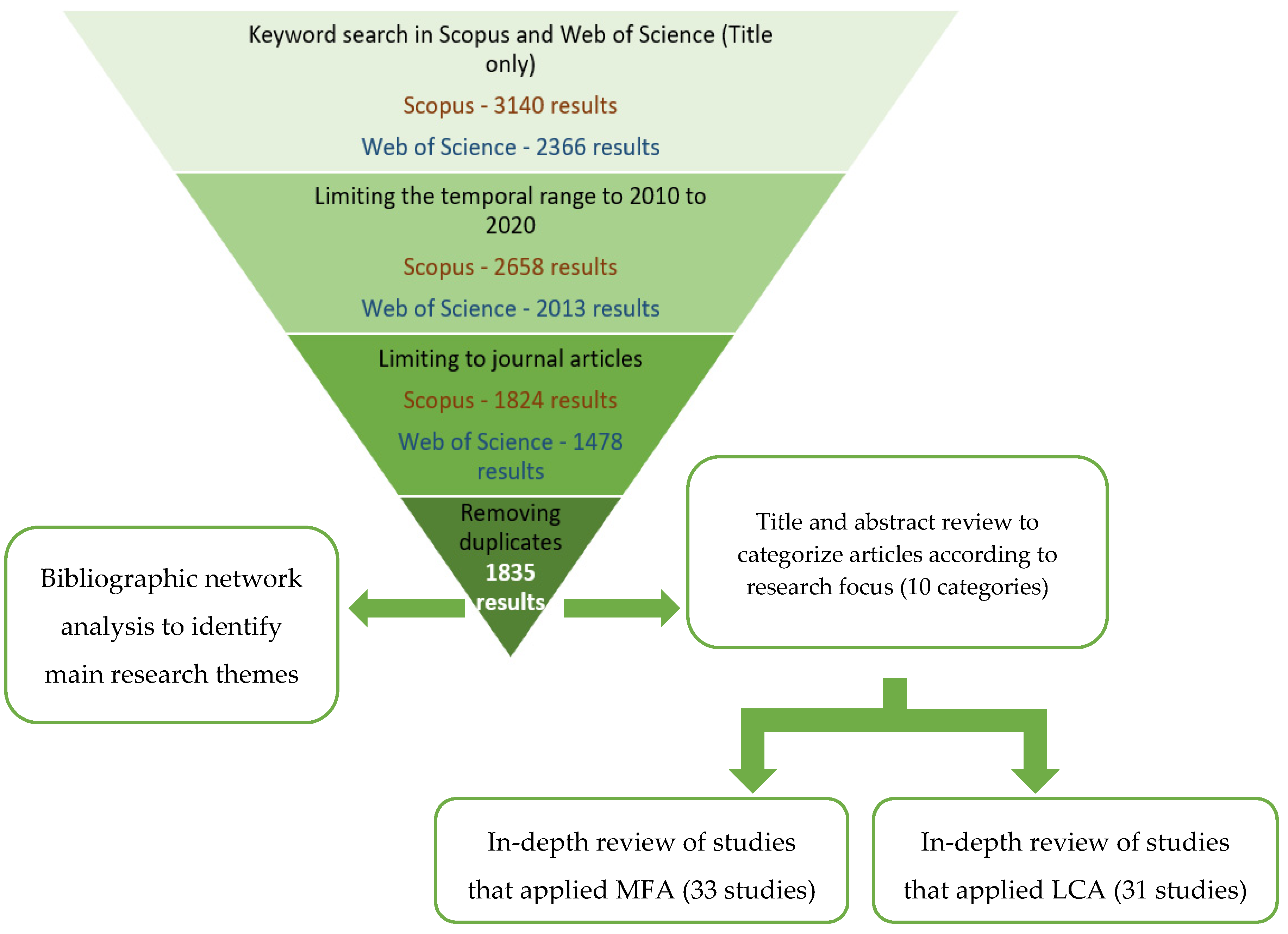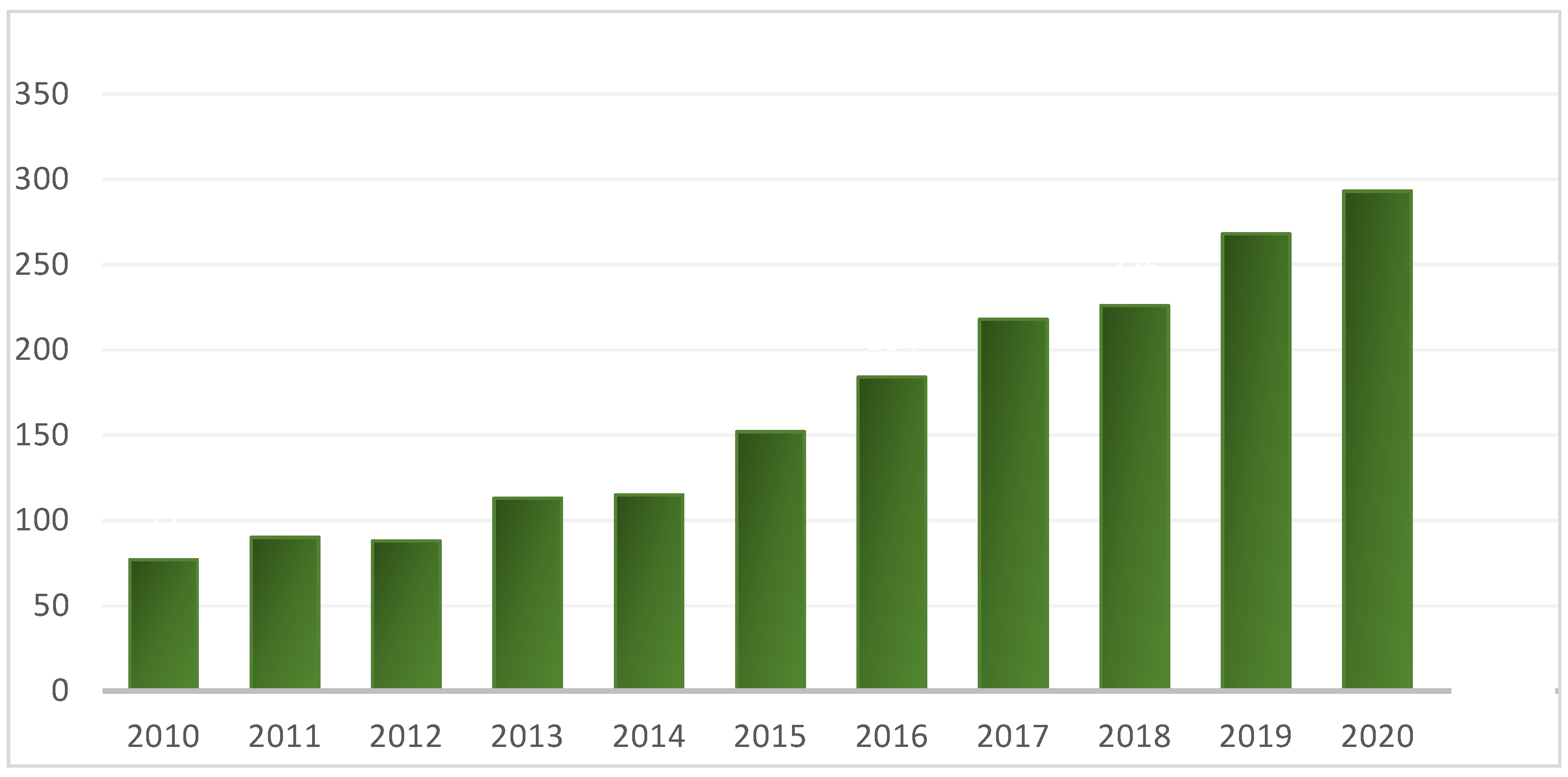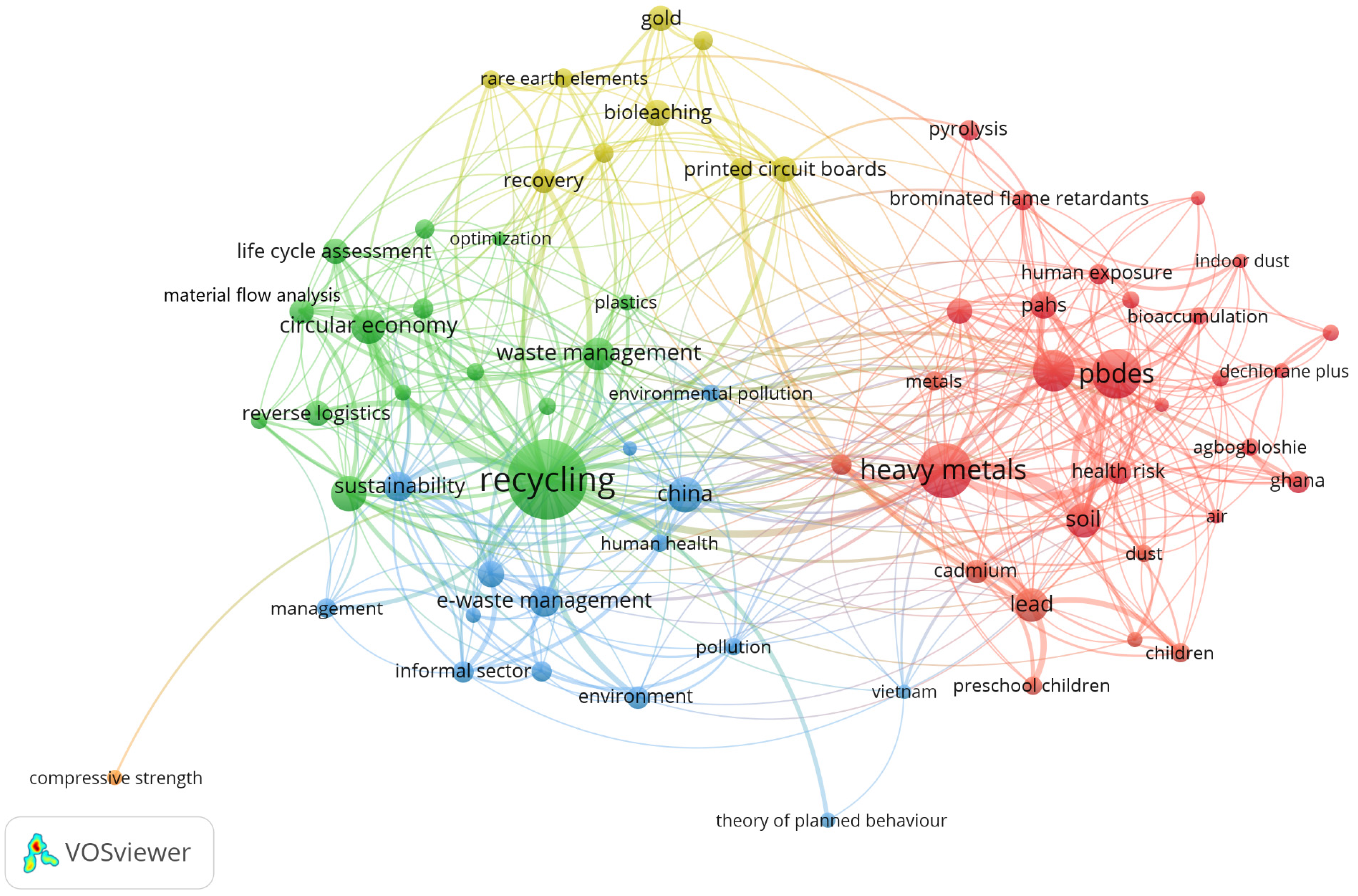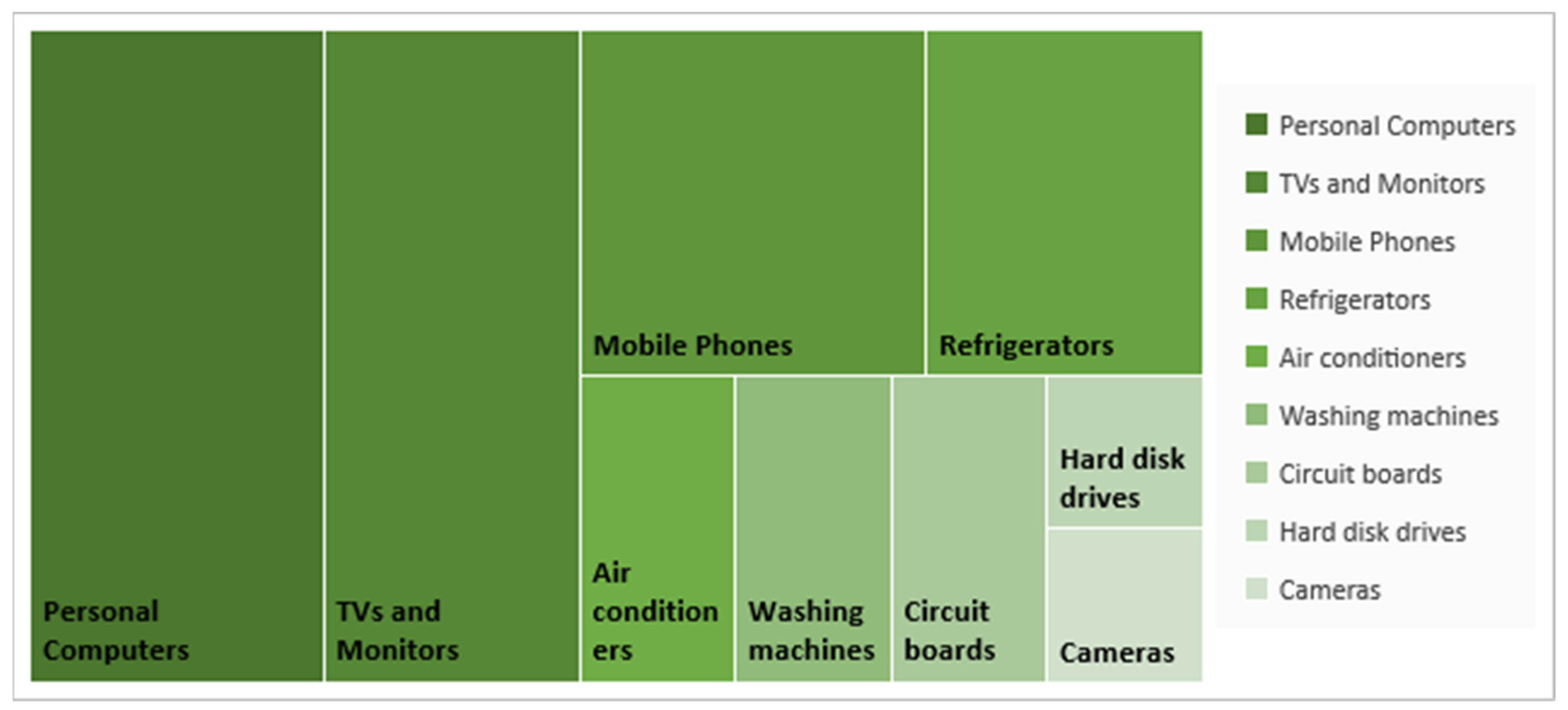Life Cycle Assessment and Material Flow Analysis: Two Under-Utilized Tools for Informing E-Waste Management
Abstract
:1. Introduction
1.1. Electrical and Electronic Equipment and E-Waste
- Temperature exchange equipment (cooling and freezing equipment)—includes refrigerators, freezers, air-conditioners, and heat pumps
- Screens and monitors—includes televisions, computer monitors, laptops, notebooks and tablets
- Lamps—includes florescent lamps, LED lamps and high intensity discharge lamps
- Large equipment—includes washers, dryers, dishwashers, electric stoves, large printing and copying equipment, and photovoltaic panels
- Small equipment—includes vacuum cleaners, microwaves, ventilation equipment, toasters, electric kettles, electrical and electronic toys, and small medical devices
- Small IT and telecommunication equipment—includes mobile phones, global positioning systems (GPS), pocket calculators, personal computers, printers, and telephones
1.2. Trends in Global E-Waste Generation
1.3. Impacts Associated With E-Waste
1.4. Opportunities for Material Recovery
1.5. Managing E-Waste
1.6. Tools for Assessing WEEE Generation, Management, and Associated Impacts
1.7. Rationale and Objectives
2. Materials and Methods
2.1. Bibliographic Network Analysis
2.2. In-Depth Desk Review
3. Results
3.1. Prominent Branches of E-Waste Research
3.2. Categorization of E-Waste Research According to the Research Focus
3.3. Application of MFA in E-Waste Research
3.4. Application of LCA in E-Waste Research
3.4.1. Category 1: Literature Reviews on LCA Studies Related to E-Waste
3.4.2. Category 2: Methodological Frameworks for WEEE Management/Treatment
3.4.3. Category 3: LCA of WEEE Treatment Systems/Methods
3.5. Research Gaps in Existing Literature
4. Conclusions
Author Contributions
Funding
Conflicts of Interest
Abbreviations
| EEE | electrical and electronic equipment |
| Mt | metric tonnes |
| MFA | material flow analysis |
| EoL | end-of-life |
| WEEE | waste electrical and electronic equipment |
| EU | European Union |
| REEs | rare earth elements |
| CRMs | critical raw materials |
| LCA | life cycle assessment |
| SLNA | systematic literature network analysis |
| LCD | liquid crystal display |
| CRT | cathode ray tube |
| PBDEs | polybrominated diphenyl ethers |
| PCBs | polychlorinated biphenyls |
References
- Parajuly, K.; Habib, K.; Liu, G. Waste electrical and electronic equipment (WEEE) in Denmark: Flows, quantities and management. Resour. Conserv. Recycl. 2017, 123, 85–92. [Google Scholar] [CrossRef]
- Forti, V.; Baldé, C.P.; Kuehr, R.; Bel, G. The Global E-Waste Monitor 2020: Quantities, Flows and the Circular Economy Potential; United Nations University (UNU): Bonn, Germany; United Nations Institute for Training and Research (UNITAR): Bonn, Germany; International Telecommunication Union (ITU): Geneva, Switzerland; International Solid Waste Association (ISWA): Rotterdam, The Netherlands, 2020; p. 120. Available online: https://www.itu.int/en/ITU-D/Environment/Documents/Toolbox/GEM_2020_def.pdf (accessed on 19 September 2020).
- Lau, W.K.-Y.; Chung, S.-S.; Zhang, C. A material flow analysis on current electrical and electronic waste disposal from Hong Kong households. Waste Manag. 2013, 33, 714–721. [Google Scholar] [CrossRef] [PubMed]
- Kumar, A.; Holuszko, M. Electronic Waste and Existing Processing Routes: A Canadian Perspective. Resources 2016, 5, 35. [Google Scholar] [CrossRef] [Green Version]
- Mohammadi, E.; Singh, S.J.; Habib, K. Electronic waste in the Caribbean: An impending environmental disaster or an opportunity for a circular economy? Resour. Conserv. Recycl. 2021, 164, 105106. [Google Scholar] [CrossRef]
- Step Initiative. Solving the E-Waste Problem (Step) White Paper: One Global Definition of E-Waste; Step Initiative: Bonn, Germany; United Nations University: Bonn, Germany, 2014; Available online: https://collections.unu.edu/view/UNU:6120#viewAttachments (accessed on 19 September 2020).
- Balde, C.P.; Forti, V.; Gray, V.; Kuher, R.; Stegmann, P. Global E-Waste Monitor 2017; United Nations University (UNU): Bonn, Germany; International Telecommunications Union (ITU): Geneva, Switzerland; International Solid Waste Association (ISWA): Vienna, Austria, 2017; Available online: https://collections.unu.edu/eserv/UNU:6341/Global-E-waste_Monitor_2017__electronic_single_pages_.pdf (accessed on 19 September 2020).
- Forti, V.; Baldé, C.; Kuehr, R. E-Waste Statistics Guidelines on Classification, Reporting and Indicators, 2nd ed.; United Nations University: Bonn, Germany, 2018; ISBN 978-92-808-9067-9. [Google Scholar]
- European Commission. Directive 2012/19/EU of the European Parliament and of the Council of 4 July 2012 on Waste Electrical and Electronic Equipment (WEEE) Text with EEA relevance. Off. J. 2012, L197, 38–71. [Google Scholar]
- Robinson, B.H. E-waste: An assessment of global production and environmental impacts. Sci. Total Environ. 2009, 408, 183–191. [Google Scholar] [CrossRef]
- The World Economic Forum. A New Circular Vision for Electronics. Time for a Global Reboot; 3 Cologny; United Nations E-Waste Coalition: Geneva, Switzerland, 2019; p. 23. Available online: http://www3.weforum.org/docs/WEF_A_New_Circular_Vision_for_Electronics.pdf (accessed on 20 September 2020).
- Li, W.; Achal, V. Environmental and health impacts due to e-waste disposal in China—A review. Sci. Total Environ. 2020, 737, 139745. [Google Scholar] [CrossRef]
- Yekeen, T.A.; Xu, X.; Zhang, Y.; Wu, Y.; Kim, S.; Reponen, T.; Dietrich, K.N.; Ho, S.; Chen, A.; Huo, X. Assessment of health risk of trace metal pollution in surface soil and road dust from e-waste recycling area in China. Environ. Sci. Pollut. Res. 2016, 23, 17511–17524. [Google Scholar] [CrossRef] [PubMed] [Green Version]
- Grant, K.; Goldizen, F.C.; Sly, P.D.; Brune, M.-N.; Neira, M.; van den Berg, M.; Norman, R.E. Health consequences of exposure to e-waste: A systematic review. Lancet Glob. Health 2013, 1, e350–e361. [Google Scholar] [CrossRef] [Green Version]
- Habib, K.; Parajuly, K.; Wenzel, H. Tracking the Flow of Resources in Electronic Waste—The Case of End-of-Life Computer Hard Disk Drives. Environ. Sci. Technol. 2015, 49, 12441–12449. [Google Scholar] [CrossRef]
- Bakhiyi, B.; Gravel, S.; Ceballos, D.; Flynn, M.A.; Zayed, J. Has the question of e-waste opened a Pandora’s box? An overview of unpredictable issues and challenges. Environ. Int. 2018, 110, 173–192. [Google Scholar] [CrossRef]
- Cucchiella, F.; D’Adamo, I.; Lenny Koh, S.C.; Rosa, P. Recycling of WEEEs: An economic assessment of present and future e-waste streams. Renew. Sustain. Energy Rev. 2015, 51, 263–272. [Google Scholar] [CrossRef] [Green Version]
- Habib, K.; Hamelin, L.; Wenzel, H. A dynamic perspective of the geopolitical supply risk of metals. J. Clean. Prod. 2016, 133, 850–858. [Google Scholar] [CrossRef]
- Charles, R.G.; Douglas, P.; Dowling, M.; Liversage, G.; Davies, M.L. Towards Increased Recovery of Critical Raw Materials from WEEE–evaluation of CRMs at a component level and pre-processing methods for interface optimisation with recovery processes. Resour. Conserv. Recycl. 2020, 161, 104923. [Google Scholar] [CrossRef]
- Habib, K.; Wenzel, H. Exploring rare earths supply constraints for the emerging clean energy technologies and the role of recycling. J. Clean. Prod. 2014, 84, 348–359. [Google Scholar] [CrossRef]
- Gradin, K.T.; Poulikidou, S.; Björklund, A.; Luttropp, C. Scrutinising the electric vehicle material backpack. J. Clean. Prod. 2018, 172, 1699–1710. [Google Scholar] [CrossRef]
- Habib, K. Critical Resources in Clean Energy Technologies and Waste Flows. PhD Thesis, University of Southern Denmark, Odense, Denmark, 2015. Available online: https://findresearcher.sdu.dk:8443/ws/files/173370487/PhD_thesis_Komal_Habib.pdf (accessed on 19 September 2020).
- Prodius, D.; Gandha, K.; Mudring, A.-V.; Nlebedim, I. Sustainable Urban Mining of Critical Elements from Magnet and Electronic Wastes. ACS Sustain. Chem. Eng. 2019, 8, 1455–1463. [Google Scholar] [CrossRef]
- Sun, Z.; Cao, H.; Xiao, Y.; Sietsma, J.; Jin, W.; Agterhuis, H.; Yang, Y. Toward Sustainability for Recovery of Critical Metals from Electronic Waste: The Hydrochemistry Processes. ACS Sustain. Chem. Eng. 2017, 5, 21–40. [Google Scholar] [CrossRef]
- Mirgorod, Y.A.; Borshch, N.A.; Borodina, V.G.; Yurkov, G.Y.; Timakov, D.I. Preparation of gold nanoparticles from the metal scrap. Theor. Found. Chem. Eng. 2014, 48, 487–492. [Google Scholar] [CrossRef]
- Sethurajan, M.; Hullebusch, E.D.; van Fontana, D.; Akcil, A.; Deveci, H.; Batinic, B.; Leal, J.P.; Gasche, T.A.; Kucuker, M.A.; Kuchta, K.; et al. Recent advances on hydrometallurgical recovery of critical and precious elements from end of life electronic wastes—A review. Crit. Rev. Environ. Sci. Technol. 2019, 49, 212–275. [Google Scholar] [CrossRef] [Green Version]
- Marra, A.; Cesaro, A.; Belgiorno, V. Recovery opportunities of valuable and critical elements from WEEE treatment residues by hydrometallurgical processes. Environ. Sci. Pollut. Res. Int. 2019, 26, 19897–19905. [Google Scholar] [CrossRef]
- Islam, M.T.; Huda, N. Material flow analysis (MFA) as a strategic tool in E-waste management: Applications, trends and future directions. J. Environ. Manag. 2019, 244, 344–361. [Google Scholar] [CrossRef]
- Kiddee, P.; Naidu, R.; Wong, M.H. Electronic waste management approaches: An overview. Waste Manag. 2013, 33, 1237–1250. [Google Scholar] [CrossRef]
- Brunner, P.H.; Rechberger, H. Practical Handbook of Material Flow Analysis. In Advanced Methods in Resource and Waste Management; CRC, Lewis: Boca Raton, FL, USA, 2004; ISBN 978-1-56670-604-9. [Google Scholar]
- Cordova-Pizarro, D.; Aguilar-Barajas, I.; Romero, D.; Rodriguez, C.A. Circular Economy in the Electronic Products Sector: Material Flow Analysis and Economic Impact of Cellphone E-Waste in Mexico. Sustainability 2019, 11, 1361. [Google Scholar] [CrossRef] [Green Version]
- Althaf, S.; Babbitt, C.W.; Chen, R. Forecasting electronic waste flows for effective circular economy planning. Resour. Conserv. Recycl. 2019, 151, 104362. [Google Scholar] [CrossRef]
- Ismail, H.; Hanafiah, M.M. An overview of LCA application in WEEE management: Current practices, progress and challenges. J. Clean. Prod. 2019, 232, 79–93. [Google Scholar] [CrossRef]
- Xue, M.; Xu, Z. Application of Life Cycle Assessment on Electronic Waste Management: A Review. Environ. Manag. 2017, 59, 693–707. [Google Scholar] [CrossRef] [PubMed]
- Finnveden, G.; Björklund, A.; Moberg, Å.; Ekvall, T.; Moberg, Å. Environmental and economic assessment methods for waste management decision-support: Possibilities and limitations. Waste Manag. Res. 2007, 25, 263–269. [Google Scholar] [CrossRef]
- Ikhlayel, M. Environmental impacts and benefits of state-of-the-art technologies for E-waste management. Waste Manag. 2017, 68, 458–474. [Google Scholar] [CrossRef]
- Menikpura, S.N.M.; Santo, A.; Hotta, Y. Assessing the climate co-benefits from Waste Electrical and Electronic Equipment (WEEE) recycling in Japan. J. Clean. Prod. 2014, 74, 183–190. [Google Scholar] [CrossRef]
- Pérez-Belis, V.; Bovea, M.; Ibáñez-Forés, V. An in-depth literature review of the waste electrical and electronic equipment context: Trends and evolution. Waste Manag. Res. 2015, 33, 3–29. [Google Scholar] [CrossRef] [PubMed]
- Ismail, H.; Hanafiah, M.M. A review of sustainable e-waste generation and management: Present and future perspectives. J. Environ. Manag. 2020, 264, 110495. [Google Scholar] [CrossRef] [PubMed]
- Khitous, F.; Strozzi, F.; Urbinati, A.; Alberti, F. A Systematic Literature Network Analysis of Existing Themes and Emerging Research Trends in Circular Economy. Sustainability 2020, 12, 1633. [Google Scholar] [CrossRef] [Green Version]
- Bamel, U.K.; Pandey, R.; Gupta, A. Safety climate: Systematic literature network analysis of 38 years (1980-2018) of research. Accid. Anal. Prev. 2020, 135, 105387. [Google Scholar] [CrossRef] [PubMed]
- van Eck, N.J.; Waltman, L. VOSviewer-Visualizing Scientific Landscapes [Software]. Available online: https://www.vosviewer.com// (accessed on 15 February 2021).
- van Eck, N.J.; Waltman, L. Software survey: VOSviewer, a computer program for bibliometric mapping. Scientometrics 2010, 84, 523–538. [Google Scholar] [CrossRef] [Green Version]
- Ottoni, M.; Dias, P.; Xavier, L.H. A circular approach to the e-waste valorization through urban mining in Rio de Janeiro, Brazil. J. Clean. Prod. 2020, 261, 120990. [Google Scholar] [CrossRef]
- Singh, A.; Panchal, R.; Naik, M. Circular economy potential of e-waste collectors, dismantlers, and recyclers of Maharashtra: A case study. Environ. Sci. Pollut. Res. 2020, 27, 22081–22099. [Google Scholar] [CrossRef]
- Nowakowski, P.; Mrówczyńska, B. Towards sustainable WEEE collection and transportation methods in circular economy—Comparative study for rural and urban settlements. Resour. Conserv. Recycl. 2018, 135, 93–107. [Google Scholar] [CrossRef]
- Wagner, F.; Peeters, J.R.; De Keyzer, J.; Janssens, K.; Duflou, J.R.; Dewulf, W. Towards a more circular economy for WEEE plastics—Part A: Development of innovative recycling strategies. Waste Manag. 2019, 100, 269–277. [Google Scholar] [CrossRef]
- Corsini, F.; Gusmerotti, N.; Frey, M. Consumer’s Circular Behaviors in Relation to the Purchase, Extension of Life, and End of Life Management of Electrical and Electronic Products: A Review. Sustainability 2020, 12, 443. [Google Scholar] [CrossRef]
- Habib, K. A product classification approach to optimize circularity of critical resources—The case of NdFeB magnets. J. Clean. Prod. 2019, 230, 90–97. [Google Scholar] [CrossRef]
- Islam, M.T.; Huda, N. Reverse logistics and closed-loop supply chain of Waste Electrical and Electronic Equipment (WEEE)/E-waste: A comprehensive literature review. Resour. Conserv. Recycl. 2018, 137, 48–75. [Google Scholar] [CrossRef]
- Allesch, A.; Brunner, P.H. Material Flow Analysis as a Tool to improve Waste Management Systems: The Case of Austria. Environ. Sci. Technol. 2017, 51, 540–551. [Google Scholar] [CrossRef]
- Agamuthu, P.; Kasapo, P.; Mohd Nordin, N.A. E-waste flow among selected institutions of higher learning using material flow analysis model. Resour. Conserv. Recycl. 2015, 105, 177–185. [Google Scholar] [CrossRef]
- Althaf, S.; Babbitt, C.W.; Chen, R. The evolution of consumer electronic waste in the United States. J. Ind. Ecol. 2020. [Google Scholar] [CrossRef]
- Yedla, S. Development of a methodology for electronic waste estimation: A material flow analysis-based SYE-Waste Model. Waste Manag. Res. 2016, 34, 81–86. [Google Scholar] [CrossRef] [PubMed]
- Park, J.; Hong, S.; Kim, I.; Lee, J.; Hur, T. Dynamic material flow analysis of steel resources in Korea. Resour. Conserv. Recycl. 2011, 55, 456–462. [Google Scholar] [CrossRef]
- Clarke, C.; Williams, I.D.; Turner, D.A. Evaluating the carbon footprint of WEEE management in the UK. Resour. Conserv. Recycl. 2019, 141, 465–473. [Google Scholar] [CrossRef]
- Golev, A.; Schmeda-Lopez, D.R.; Smart, S.K.; Corder, G.D.; McFarland, E.W. Where next on e-waste in Australia? Waste Manag. 2016, 58, 348–358. [Google Scholar] [CrossRef]
- Vanegas, P.; Peeters, J.R.; Cattrysse, D.; Dewulf, W.; Duflou, J.R. Improvement potential of today’s WEEE recycling performance: The case of LCD TVs in Belgium. Front. Environ. Sci. Eng. 2017, 11, 13. [Google Scholar] [CrossRef]
- Babayemi, J.O.; Osibanjo, O.; Weber, R. Material and substance flow analysis of mobile phones in Nigeria: A step for progressing e-waste management strategy. J. Mater. Cycles Waste Manag. 2017, 19, 731–742. [Google Scholar] [CrossRef]
- Gusukuma, M.; Kahhat, R. Electronic waste after a digital TV transition: Material flows and stocks. Resour. Conserv. Recycl. 2018, 138, 142–150. [Google Scholar] [CrossRef]
- Yi, S.; Lee, H.; Lee, J.; Kim, W. Upcycling strategies for waste electronic and electrical equipment based on material flow analysis. Environ. Eng. Res. 2019, 24, 74–81. [Google Scholar] [CrossRef] [Green Version]
- Lam, C.W.; Lim, S.-R.; Schoenung, J.M. Linking Material Flow Analysis with Environmental Impact Potential. J. Ind. Ecol. 2013, 17, 299–309. [Google Scholar] [CrossRef]
- Andarani, P.; Goto, N. Potential e-waste generated from households in Indonesia using material flow analysis. J. Mater. Cycles Waste Manag. 2014, 16, 306–320. [Google Scholar] [CrossRef]
- Cao, J.; Chen, Y.; Shi, B.; Lu, B.; Zhang, X.; Ye, X.; Zhai, G.; Zhu, C.; Zhou, G. WEEE recycling in Zhejiang Province, China: Generation, treatment, and public awareness. J. Clean. Prod. 2016, 127, 311–324. [Google Scholar] [CrossRef]
- Bahers, J.-B.; Kim, J. Regional approach of waste electrical and electronic equipment (WEEE) management in France. Resour. Conserv. Recycl. 2018, 129, 45–55. [Google Scholar] [CrossRef]
- Gonda, L.; D’Ans, P.; Degrez, M. A comparative assessment of WEEE collection in an urban and rural context: Case study on desktop computers in Belgium. Resour. Conserv. Recycl. 2019, 142, 131–142. [Google Scholar] [CrossRef]
- Davis, J.-M. A model to rapidly assess informal electronic waste systems. Waste Manag. Res. 2020, 39, 101–107. [Google Scholar] [CrossRef]
- Ueberschaar, M.; Geiping, J.; Zamzow, M.; Flamme, S.; Rotter, V.S. Assessment of element-specific recycling efficiency in WEEE pre-processing. Resour. Conserv. Recycl. 2017, 124, 25–41. [Google Scholar] [CrossRef] [Green Version]
- Sommer, P.; Rotter, V.S.; Ueberschaar, M. Battery related cobalt and REE flows in WEEE treatment. Waste Manag. 2015, 45, 298–305. [Google Scholar] [CrossRef] [PubMed]
- De Meester, S.; Nachtergaele, P.; Debaveye, S.; Vos, P.; Dewulf, J. Using material flow analysis and life cycle assessment in decision support: A case study on WEEE valorization in Belgium. Resour. Conserv. Recycl. 2019, 142, 1–9. [Google Scholar] [CrossRef]
- Wäger, P.A.; Hischier, R.; Eugster, M. Environmental impacts of the Swiss collection and recovery systems for Waste Electrical and Electronic Equipment (WEEE): A follow-up. Sci. Total Environ. 2011, 409, 1746–1756. [Google Scholar] [CrossRef]
- Song, Q.; Wang, Z.; Li, J. Sustainability evaluation of e-waste treatment based on emergy analysis and the LCA method: A case study of a trial project in Macau. Ecol. Indic. 2013, 30, 138–147. [Google Scholar] [CrossRef]
- Rebitzer, G.; Ekvall, T.; Frischknecht, R.; Hunkeler, D.; Norris, G.; Rydberg, T.; Schmidt, W.-P.; Suh, S.; Weidema, B.; Pennington, D. Life Cycle Assessment Part 1: Framework, Goal and Scope Definition, Inventory Analysis, and Applications. Environ. Int. 2004, 30, 701–720. [Google Scholar] [CrossRef]
- deSouza, R.G.; Clímaco, J.C.N.; Sant’Anna, A.P.; Rocha, T.B.; doValle, R.D.A.B.; Quelhas, O.L.G. Sustainability assessment and prioritisation of e-waste management options in Brazil. Waste Manag. 2016, 57, 46–56. [Google Scholar] [CrossRef] [PubMed] [Green Version]
- Song, X.; Wang, J.; Yang, J.; Lu, B. An updated review and conceptual model for optimizing WEEE management in China from a life cycle perspective. Front. Environ. Sci. Eng. 2017, 11, 3. [Google Scholar] [CrossRef]
- Jaunich, M.K.; DeCarolis, J.; Handfield, R.; Kemahlioglu-Ziya, E.; Ranjithan, S.R.; Moheb-Alizadeh, H. Life-cycle modeling framework for electronic waste recovery and recycling processes. Resour. Conserv. Recycl. 2020, 161, 104841. [Google Scholar] [CrossRef]
- Rigamonti, L.; Falbo, A.; Zampori, L.; Sala, S. Supporting a transition towards sustainable circular economy: Sensitivity analysis for the interpretation of LCA for the recovery of electric and electronic waste. Int. J. Life Cycle Assess. 2017, 22, 1278–1287. [Google Scholar] [CrossRef] [Green Version]
- Gamberini, R.; Gebennini, E.; Manzini, R.; Ziveri, A. On the integration of planning and environmental impact assessment for a WEEE transportation network—A case study. Resour. Conserv. Recycl. 2010, 54, 937–951. [Google Scholar] [CrossRef]
- Solé, M.; Watson, J.; Puig, R.; Fullana-i-Palmer, P. Proposal of a new model to improve the collection of small WEEE: A pilot project for the recovery and recycling of toys. Waste Manag. Res. 2012, 30, 1208–1212. [Google Scholar] [CrossRef] [PubMed]
- Baxter, J.; Lyng, K.-A.; Askham, C.; Hanssen, O.J. High-quality collection and disposal of WEEE: Environmental impacts and resultant issues. Waste Manag. 2016, 57, 17–26. [Google Scholar] [CrossRef]
- Lu, B.; Song, X.; Yang, J.; Yang, D. Comparison on End-of-Life strategies of WEEE in China based on LCA. Front. Environ. Sci. Eng. 2017, 11, 7. [Google Scholar] [CrossRef]
- Barletta, I.; Larborn, J.; Mani, M.; Johannson, B. Towards an Assessment Methodology to Support Decision Making for Sustainable Electronic Waste Management Systems: Automatic Sorting Technology. Sustainability 2016, 8, 84. [Google Scholar] [CrossRef] [Green Version]
- Li, Z.; Diaz, L.A.; Yang, Z.; Jin, H.; Lister, T.E.; Vahidi, E.; Zhao, F. Comparative life cycle analysis for value recovery of precious metals and rare earth elements from electronic waste. Resour. Conserv. Recycl. 2019, 149, 20–30. [Google Scholar] [CrossRef]
- Lu, B.; Liu, J.; Yang, J.; Li, B. The environmental impact of technology innovation on WEEE management by Multi-Life Cycle Assessment. J. Clean. Prod. 2015, 89, 148–158. [Google Scholar] [CrossRef]
- Shaikh, S.; Thomas, K.; Zuhair, S.; Magalini, F. A cost-benefit analysis of the downstream impacts of e-waste recycling in Pakistan. Waste Manag. 2020, 118, 302–312. [Google Scholar] [CrossRef]
- Hong, J.; Shi, W.; Wang, Y.; Chen, W.; Li, X. Life cycle assessment of electronic waste treatment. Waste Manag. 2015, 38, 357–365. [Google Scholar] [CrossRef]
- Song, Q.; Zeng, X.; Li, J.; Duan, H.; Yuan, W. Environmental risk assessment of CRT and PCB workshops in a mobile e-waste recycling plant. Environ. Sci. Pollut. Res. Int. 2015, 22, 12366–12373. [Google Scholar] [CrossRef]
- Gaikwad, V.; Ghose, A.; Cholake, S.; Rawal, A.; Iwato, M.; Sahajwalla, V. Transformation of E-Waste Plastics into Sustainable Filaments for 3D Printing. ACS Sustain. Chem. Eng. 2018, 6, 14432–14440. [Google Scholar] [CrossRef]
- Iannicelli-Zubiani, E.M.; Giani, M.I.; Recanati, F.; Dotelli, G.; Puricelli, S.; Cristiani, C. Environmental impacts of a hydrometallurgical process for electronic waste treatment: A life cycle assessment case study. J. Clean. Prod. 2017, 140, 1204–1216. [Google Scholar] [CrossRef]
- Villares, M.; Işıldar, A.; Mendoza Beltran, A.; Guinee, J. Applying an ex-ante life cycle perspective to metal recovery from e-waste using bioleaching. J. Clean. Prod. 2016, 129, 315–328. [Google Scholar] [CrossRef]
- Bigum, M.; Damgaard, A.; Scheutz, C.; Christensen, T.H. Environmental impacts and resource losses of incinerating misplaced household special wastes (WEEE, batteries, ink cartridges and cables). Resour. Conserv. Recycl. 2017, 122, 251–260. [Google Scholar] [CrossRef]
- Boldoczki, S.; Thorenz, A.; Tuma, A. The environmental impacts of preparation for reuse: A case study of WEEE reuse in Germany. J. Clean. Prod. 2020, 252, 119736. [Google Scholar] [CrossRef]






| Research Focus | No of Articles | Description | |
|---|---|---|---|
| 1 | Environmental or human health impacts | 717 | Ecological risk and human health implications resulting from improper handling and exposure to e-waste due to heavy metals and toxic chemicals |
| 2 | Recycling and recovery technologies | 458 | Methods, technologies, processes, and assessments of reuse and recycling of e-waste and material recovery aspects |
| 3 | E-waste generation estimates and general management | 222 | General management of e-waste, national/provincial-level estimations, predominant issues in collection, and overall management |
| 4 | Policy and regulations | 105 | Policies, legislations, and regulatory frameworks related to e-waste |
| 5 | Material/chemical characterization | 77 | Characterization of material and chemical composition of e-waste products |
| 6 | Associated social aspects | 58 | Social costs and benefits, consumer attitudes, perceptions, and behaviors related to e-waste |
| 7 | Circular economy aspects * | 42 | Studies that discussed CE concept as a main theme |
| 8 | Material Flow Analysis (MFA) * | 33 | Studies that utilized MFA as a tool in achieving the research objective |
| 9 | Life Cycle Assessment (LCA) * | 31 | Studies that utilized LCA as a tool in achieving the research objective |
| 10 | Other | 89 | Studies that could not be categorized into any of the other categories |
Publisher’s Note: MDPI stays neutral with regard to jurisdictional claims in published maps and institutional affiliations. |
© 2021 by the authors. Licensee MDPI, Basel, Switzerland. This article is an open access article distributed under the terms and conditions of the Creative Commons Attribution (CC BY) license (https://creativecommons.org/licenses/by/4.0/).
Share and Cite
Withanage, S.V.; Habib, K. Life Cycle Assessment and Material Flow Analysis: Two Under-Utilized Tools for Informing E-Waste Management. Sustainability 2021, 13, 7939. https://doi.org/10.3390/su13147939
Withanage SV, Habib K. Life Cycle Assessment and Material Flow Analysis: Two Under-Utilized Tools for Informing E-Waste Management. Sustainability. 2021; 13(14):7939. https://doi.org/10.3390/su13147939
Chicago/Turabian StyleWithanage, Sohani Vihanga, and Komal Habib. 2021. "Life Cycle Assessment and Material Flow Analysis: Two Under-Utilized Tools for Informing E-Waste Management" Sustainability 13, no. 14: 7939. https://doi.org/10.3390/su13147939
APA StyleWithanage, S. V., & Habib, K. (2021). Life Cycle Assessment and Material Flow Analysis: Two Under-Utilized Tools for Informing E-Waste Management. Sustainability, 13(14), 7939. https://doi.org/10.3390/su13147939





